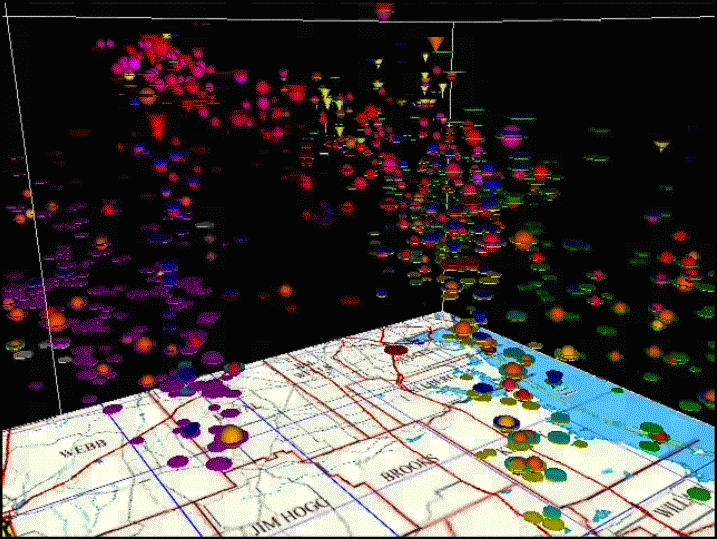|
... II. The Framework ...
values

 paradoxes
paradoxes
|

Figure 38. Three-dimensional rotation fields, or hydrocarbon production locations, for Texas Railroad Commission District 4 in South Texas.
The purple disks represent locations of fields in a geologic formation named the Wilcox.
Note that the Vicksburg production (yellow disks) sits in front of and above the Wilcox, and that the Frio (green disks) sit in
front of and above the Vicksburg production. The Wilcox sediments were deposited first, then the Vicksburg sediments were
laid down on top of the Wilcox and in the Gulf of Mexico to the southeast, then the Frio sediments were laid on top of the
Vicksburg and off in the Gulf of Mexico, again to the southeast. The gap is where very few oil fields have been found so far.
The geology in this gap is not made up by layers of beach sands and the build-up of ancient reefs.
Rather, the gap consists of deep water clays, with interspersed submarine canyon sand turbidity flows, or turbidites.
These are the same kind of reservoirs which have been so successfully explored for in the deep water Gulf of Mexico in
the late 1990ís and early 2000ís. The two differences are: (1) that this area of the gap is onshore, where it is harder to
get a consistent coupling between seismic sources and receivers than it is when collecting seismic data offshore; and
(2) that the infrastructure costs are a fraction of the costs of deepwater platforms and pipelines.
And even with this convincing scientific evidence, and the high price of hydrocarbons,
it is almost impossible to raise money to explore in a different way in a mature area. Similarly, I anticipate it will be hard to
convince scientists and theologians of the value and benefits which will come from building an integrated model of their
respective data sets, in order to lookfor new patterns and insights.
|
timedex

 infinite grid
infinite grid
-102-
|